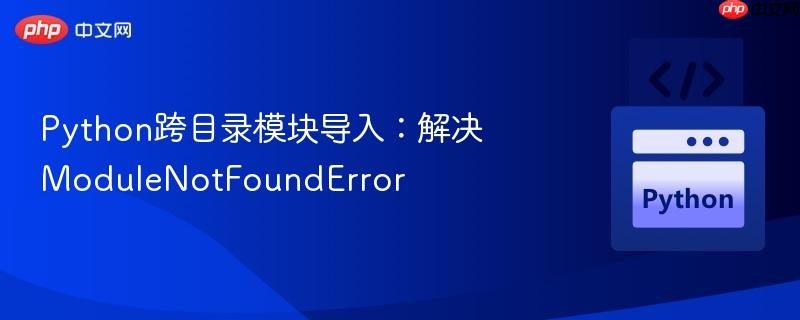
本文深入探讨了python在多目录项目结构中进行模块导入时遇到的`modulenotfounderror`问题。通过分析python的模块搜索路径机制,提供了一种动态修改`sys.path`的解决方案,使得脚本能够正确识别并导入项目根目录下的其他模块。文章包含详细的代码示例和注意事项,旨在帮助开发者构建清晰、可维护的python项目。
理解Python模块导入机制
Python在尝试导入模块时,会遵循一套特定的查找规则。它会遍历sys.path列表中定义的路径,寻找与导入语句匹配的模块或包。sys.path是一个包含字符串的列表,这些字符串指定了Python解释器查找模块的目录。通常,sys.path会包含以下路径:
当需要导入的模块或包不在sys.path中的任何一个目录里时,Python就会抛出ModuleNotFoundError。
问题场景:跨目录导入失败
在复杂的Python项目中,我们经常会将代码组织到不同的目录中,形成模块化的结构。例如,考虑以下项目结构:
project_root/
├── dir1/
│ ├── __init__.py
│ ├── helper.py
│ └── dir1.py
└── dir2/
├── __init__.py
├── dir2Functions.py
└── dir2main.py假设我们的目标是在dir1/helper.py文件中导入dir2/dir2Functions.py模块中的functionxx函数。一个直观的尝试可能是这样:
立即学习“Python免费学习笔记(深入)”;
# project_root/dir1/helper.py
from dir2.dir2Functions import functionxx
def run_helper_logic():
print("Executing helper logic...")
functionxx()
if __name__ == "__main__":
run_helper_logic()当您直接从project_root目录(或任何其他目录)运行python dir1/helper.py时,很可能会遇到以下错误:
ModuleNotFoundError: No module named 'dir2'
这个错误发生的原因是,当helper.py作为主脚本运行时,Python的sys.path中通常只包含了dir1所在的目录,而没有包含project_root。因此,Python无法将dir2识别为一个顶层包,因为它不知道dir2相对于project_root的位置。
解决方案:动态修改sys.path
解决ModuleNotFoundError的关键在于确保Python的模块搜索路径(sys.path)包含项目的根目录。一旦项目的根目录被添加到sys.path,Python就能以它为基准,正确地解析并找到dir1、dir2等子目录中的模块。
我们可以在需要进行跨目录导入的脚本的顶部,动态地将项目的根目录添加到sys.path中。以下是具体的解决方案代码:
# project_root/dir1/helper.py
import sys
from pathlib import Path
# 1. 获取当前正在执行的脚本的绝对路径
# sys.argv[0] 返回脚本的路径,例如 'dir1/helper.py'
current_script_path = Path(sys.argv[0]).resolve()
# 2. 获取当前脚本的父目录
# 例如,如果 current_script_path 是 'project_root/dir1/helper.py',
# 那么 script_parent_dir 将是 'project_root/dir1/'
script_parent_dir = current_script_path.parent
# 3. 获取项目的根目录
# 再获取一次父目录,从 'project_root/dir1/' 得到 'project_root/'
project_root = script_parent_dir.parent
# 4. 将项目根目录的字符串形式添加到 Python 的模块搜索路径中
sys.path.append(str(project_root))
# 现在可以正常导入dir2中的模块了
from dir2.dir2Functions import functionxx
def run_helper_logic():
print("Executing helper logic...")
print("Calling functionxx from dir2Functions...")
functionxx()
if __name__ == "__main__":
run_helper_logic()代码解析:
- sys.argv[0]:这是一个字符串,包含了当前正在执行的Python脚本的路径。例如,如果运行python project_root/dir1/helper.py,sys.argv[0]就是project_root/dir1/helper.py。
- from pathlib import Path:pathlib模块提供了面向对象的路径操作,比传统的os.path更易用和健壮。
- Path(sys.argv[0]):将脚本路径字符串转换为一个Path对象。
- .resolve():解析路径中的所有符号链接,并返回其绝对路径。这确保我们得到一个可靠的、完整的路径,避免因相对路径或链接引起的混淆。
- .parent:这是一个Path对象的方法,用于获取当前路径的父目录。
- 第一次调用.parent(current_script_path.parent)将得到脚本所在的目录,即project_root/dir1/。
- 第二次调用.parent(script_parent_dir.parent)将得到project_root/,这正是我们需要的项目根目录。
- sys.path.append(str(project_root)):将计算出的项目根目录的字符串形式添加到sys.path列表中。一旦project_root被添加到sys.path,Python就能以它为基准来查找dir1和dir2等子包,从而成功导入dir2.dir2Functions。
完整示例演示
为了验证上述解决方案,我们来创建一个完整的示例。
-
创建项目结构和文件:
# project_root/ # ├── dir1/ # │ ├── __init__.py # │ └── helper.py # └── dir2/ # ├── __init__.py # └── dir2Functions.py
project_root/dir1/__init__.py (空文件,表示dir1是一个包)
project_root/dir2/__init__.py (空文件,表示dir2是一个包)
-
project_root/dir2/dir2Functions.py (包含被导入的函数)
# project_root/dir2/dir2Functions.py def functionxx(): print("functionxx from dir2Functions is executed successfully!") -
project_root/dir1/helper.py (包含解决方案代码)
# project_root/dir1/helper.py import sys from pathlib import Path # 获取当前脚本的绝对路径 current_script_path = Path(sys.argv[0]).resolve() # 获取当前脚本的父目录 (dir1/) script_parent_dir = current_script_path.parent # 获取项目根目录 (project_root/) project_root = script_parent_dir.parent # 将项目根目录添加到sys.path sys.path.append(str(project_root)) # 现在可以正常导入dir2中的模块了 from dir2.dir2Functions import functionxx def run_helper_logic(): print("Executing helper logic...") print("Calling functionxx from dir2Functions...") functionxx() if __name__ == "__main__": run_helper_logic() -
运行方式:
打开终端或命令行,导航到project_root目录(或从任何位置,只要路径正确),然后执行:
python dir1/helper.py
-
预期输出:
Executing helper logic... Calling functionxx from dir2Functions... functionxx from dir2Functions is executed successfully!
注意事项与最佳实践
- 适用场景:这种动态修改sys.path的方法非常适合在开发阶段,当您需要直接运行项目内部的某个脚本,而该脚本又依赖于项目根目录下的其他模块时。它提供了一种快速解决ModuleNotFoundError的方案。
- 避免滥用:尽管有效,但频繁或随意地修改sys.path可能会导致模块查找的混乱,增加代码的复杂性和维护难度。在大型或长期项目中,应考虑更结构化的解决方案。
- 项目作为可安装的包:对于更复杂的项目,推荐将其组织成一个可安装的Python包。通过在project_root下创建setup.py或pyproject.toml文件,并使用pip install -e .(可编辑安装)将其安装到开发环境中。这样,所有模块都能像标准库一样被导入,无需手动修改sys.path。这是Python项目管理的推荐方式。
- 相对导入:如果dir1和dir2是同一个Python包的子包,并且导入发生在包内部,可以考虑使用相对导入(例如 from ..dir2.dir2Functions import functionxx)。但这要求脚本作为包的一部分被导入,而不是作为顶层脚本直接运行。
- PYTHONPATH环境变量:另一种方式是在运行脚本之前,通过设置PYTHONPATH环境变量来指定项目的根目录。例如:export PYTHONPATH=$PYTHONPATH:/path/to/project_root。这在部署或特定运行环境中可能更常见,但在代码内部修改通常更灵活。
总结
当Python在多目录项目中遇到ModuleNotFoundError时,通常是因为项目的根目录未被包含在sys.path中。通过利用sys.argv[0]和pathlib模块动态计算出项目根目录,并将其添加到sys.path,可以有效地解决这一问题,确保跨目录模块的正确导入。然而,在更大型或生产环境中,建议采用更标准化的包管理和安装实践,如使用setup.py或pyproject.toml将项目构建为可安装的Python包。






























